We understand you may have many questions, and we would like to help. Dr. Sepehr has provided answers to some of the most commonly asked questions about facelift surgery to aid you in your research. If you would like to learn more, or if you’re ready to schedule a consultation, please contact our skilled medical team.
Is a facelift right for me?
Are you bothered by skin laxity and contour loss on your mid to lower face and jawline? Facelift surgery is designed to improve these concerns and provide long-lasting facial rejuvenation. Ideal candidates for this procedure will also be in good general health, be nonsmokers (or able to stop smoking for a period before and after surgery), and have reasonable expectations for the outcome. Dr. Sepehr will take the time to understand your needs and goals and provide a thorough overview of what can be accomplished. With his guidance, you can develop a customized treatment plan designed with your individual characteristics in mind.
Can a facelift smooth wrinkles?
The primary purpose of a facelift is to address skin laxity and loose muscles, not necessarily to smooth wrinkles and fine lines. Some deeper creases can be addressed; however, to achieve a natural-looking outcome, it’s best to avoid stretching the skin in an attempt to artificially reduce the appearance of lines. If you have wrinkles you would like to soften, we can utilize
dermal fillers, cosmetic injectables, and facial laser skin resurfacing as part of a multi-modality treatment plan. By incorporating these techniques, you can obtain more comprehensive rejuvenation that still appears very natural.
When can I return to work?
Everyone recovers at their own unique rate, and we encourage you to listen to your body and proceed with caution. Most patients can return to their regular daily schedule after two weeks, with some individuals choosing to return after three weeks. Swelling, bruising, and numbness are common effects, and each of these should gradually subside as you heal. Additionally, you should avoid strenuous activity and exercise for at least a month to six weeks. Dr. Sepehr will provide more information specific to your treatment plan during your follow-up visits.
Does a facelift differ for men versus women?
Facelift surgery is generally the same for both men and women, but distinctions in the facial anatomy and aesthetic conventions of men versus women may influence your procedure. Male facial features are often broader and sharper, while the faces of female patients are often softer, sleeker, and more narrow. This may cause male and female patients to have different goals for the outcome. Additionally, the beard line in men can also dictate a different placement for incisions. Dr. Sepehr will take these differences into account when performing a facelift to achieve a result that looks as natural as possible.
How long before I can exercise again after a facelift?
It’s generally recommended to wait two weeks after surgery to resume mild exercise and six weeks to resume strenuous weight lifting, contact sports, and swimming, but this timeframe will vary somewhat from patient to patient. Your incisions should be fully healed and swelling should be minimal. When Dr. Sepehr clears you for exercise, he advises starting with lighter workouts and easing into more intensive exercises to see how your body responds.
Does insurance cover a facelift?
Insurance usually doesn’t cover facelift surgery, but OC Facial Plastic Surgery does accept third-party financing from CareCredit® and Prosper® Healthcare Lending. The flexible payment plans offered by each company can allow qualified patients to pay for their facelift in low monthly installments, often with little to no interest rates. Please call our office if you have any questions about our accepted payment options or the application processes for financing.
How do I reduce swelling after facelift surgery?
Dr. Sepehr will give you detailed instructions on how to best reduce swelling and encourage the healing process. After surgery, he will advise that you keep your head elevated above heart level when lying down and sleeping to better regulate blood flow. Sticking to a healthy diet of nutritious fruits and vegetables, leafy greens, proteins, and vitamin- and antioxidant-rich foods can also help you heal after a facelift. This, in combination with avoiding salty foods and alcohol, can help ensure the smoothest possible recovery period. Dr. Sepehr will also provide instructions on lymphatic drainage massage starting about three weeks after your procedure. Please keep in mind that swelling after cosmetic surgery can last for six months to one year after your procedure; however, most swelling should subside within six weeks.
Can I naturally slow down facial aging?
While nothing will stop the natural aging process, you can age more gracefully by being proactive about the health and appearance of your skin. Applying daily sun protection is absolutely essential to help safeguard the skin against damaging UVA and UVB rays. Sun damage is not only a major cause of wrinkles and premature facial aging, but it can also result in hyperpigmentation and poor skin texture overall. Facials, chemical peels, microneedling, and other med spa services also offer effective, in-office treatments to address any existing damage and renew your complexion.
Will a facelift look obvious?
A well-executed facelift should simply allow you to look like a healthier, more youthful version of yourself. In this respect, the results of a facelift can be very subtle and inconspicuous to outside observers. Modern facelift techniques have allowed the procedure to achieve outcomes that look more natural than ever. If the face appears tight, frozen, or “windswept” once healed from surgery, this is typically an indication of a poorly performed facelift. Always entrust your care to a board-certified facial plastic surgeon to help ensure you receive the best quality results from facelift surgery.
How can I prepare for facelift surgery?
If your procedure is being performed as an outpatient, you should arrange a ride to and from our surgical facility with a friend or loved one. You may also choose to stay overnight under the care of our medical team — you and Dr. Sepehr will discuss the best course of action for your personal needs. We also encourage you to enlist help around the house for the first few days of your recovery, as plenty of rest is essential to your healing process. If you smoke, you will need to abstain for at least four weeks prior to your procedure. You may also be instructed to stop taking certain medications before surgery, such as herbal supplements, aspirin, and NSAIDs.
When will I feel normal after a facelift?
In general, it takes approximately two weeks for patients to feel well enough to return to non-strenuous work. At this point, others should not be able to tell you underwent surgery and any bruising should be minimal. It can take six weeks for the majority of swelling to subside, and many patients feel relatively normal between six to eight weeks. Depending on Dr. Sepehr’s assessment of your healing, you should also be able to exercise normally. It’s important to err on the side of caution during your recovery, and not rush the body’s natural healing process.
 You are a man or woman between the ages of 30 and 80
You are a man or woman between the ages of 30 and 80 You desire significant facial rejuvenation with results that can last longer than non-surgical cosmetic enhancement and dermal fillers
You desire significant facial rejuvenation with results that can last longer than non-surgical cosmetic enhancement and dermal fillers You have excess skin and fat in the lower face and neck
You have excess skin and fat in the lower face and neck


